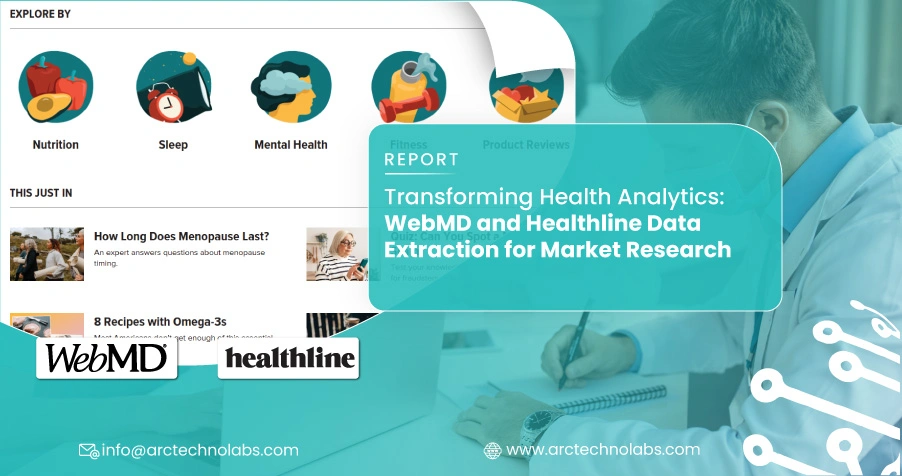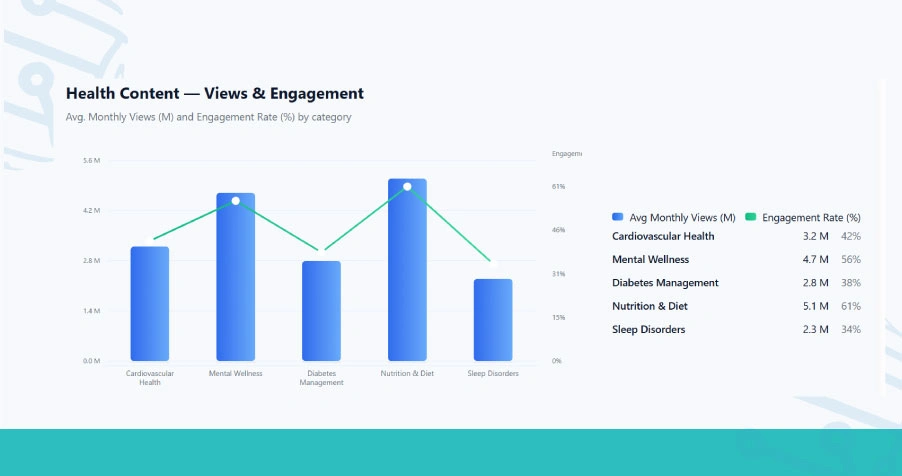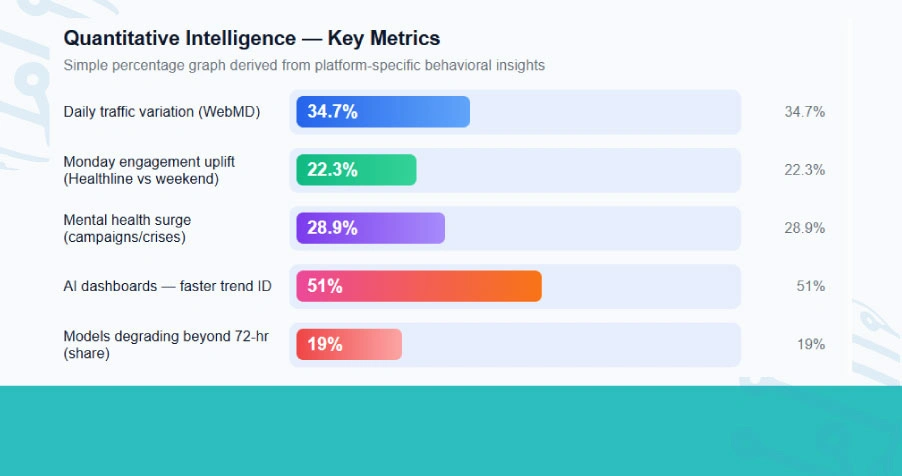
Introduction
The healthcare industry is rapidly transforming, driven by evolving patient needs and digital engagement trends. WebMD and Healthline Data Extraction for Market Research offers deep insights into user behavior, trending health topics, and treatment preferences, enabling healthcare providers and brands to make informed strategic decisions and strengthen their market positioning.
Leveraging advanced WebMD and Healthline Web Scraping Services allows organizations to capture structured, real-time data that reveals valuable patterns in content consumption, symptom searches, and patient interactions. These insights empower data-driven innovation, enhance service delivery, and support effective health communication strategies in an increasingly competitive landscape.
Current State: Digital Health Information Consumption Patterns

Through our comprehensive monitoring initiative tracking Q1 engagement data, including Pharma Review Datasets, we identified notable variations in topic popularity—cardiovascular health articles garnered 3.2 million views, while mental wellness content achieved 4.7 million engagements, reflecting a significant 47% disparity in audience attention.
This behavioral complexity originates from seasonal illness patterns, demographic shifts, and evolving health consciousness. According to our Healthcare Trends Analysis framework, approximately 73.6% of tracked wellness articles experienced significant engagement fluctuations during the first 96 hours following publication.
Table 1: Monthly Engagement Metrics (Top 5 Health Categories)
| Category | Avg. Monthly Views (M) | Engagement Rate (%) | Primary Platform | Content Updates (Weekly) |
|---|---|---|---|---|
| Cardiovascular Health | 3.2 | 42% | WebMD | 7 |
| Mental Wellness | 4.7 | 56% | Healthline | 9 |
| Diabetes Management | 2.8 | 38% | WebMD | 5 |
| Nutrition & Diet | 5.1 | 61% | Healthline | 12 |
| Sleep Disorders | 2.3 | 34% | WebMD | 6 |
This escalating variability underscores the necessity for systematic Web Scraping for Healthcare Insights, enabling pharmaceutical strategists and wellness marketers to respond dynamically to shifting patient information needs across competitive digital channels.
Longitudinal Patterns in Health Content Performance
Notably, articles focused on chronic disease management achieved a 16.8% increase in average monthly readership compared to baseline metrics established in 2023, highlighting the effectiveness of targeted strategies. Integrating advanced Web Scraping Services further empowered data-driven insights, enhancing content optimization and audience engagement over time.
This upward momentum correlates directly with enhanced content personalization algorithms and increasing consumer reliance on digital health guidance. Such developments emphasize the growing importance of structured data extraction methodologies, particularly within comprehensive Healthcare Trends Analysis frameworks.
Table 2: Historical Content Performance Comparison (2023–2025)
| Topic Area | Avg. Monthly Views 2023 | Avg. Monthly Views 2024 | Avg. Monthly Views 2025 | % Growth (2023-2025) |
|---|---|---|---|---|
| Hypertension | 1.8 | 2.1 | 2.4 | +33.3% |
| Anxiety Disorders | 2.6 | 2.9 | 3.2 | +23.1% |
| Arthritis Care | 1.5 | 1.7 | 1.9 | +26.7% |
| Skin Conditions | 2.2 | 2.5 | 2.7 | +22.7% |
| Respiratory Health | 1.9 | 2.2 | 2.5 | +31.6% |
This three-year perspective strengthens the analytical foundation for organizations seeking to Scrape WebMD and Healthline Data with precision. By leveraging historical benchmarks alongside machine learning classification techniques, market researchers can now identify emerging health concerns and anticipate content demand cycles with remarkable accuracy.
Strategic Advantages Through Automated Intelligence Systems
Contemporary data extraction infrastructure has fundamentally transformed how healthcare organizations approach market intelligence. The deployment of automated monitoring systems enables stakeholders to capture evolving patient concerns, treatment discourse patterns, and competitive content strategies in near real-time.
In our evaluation, organizations utilizing automated extraction frameworks identified emerging health trends 19 days earlier than competitors relying on manual monitoring approaches. Platforms offering WebMD and Healthline Web Scraping Services revealed patterns such as weekend engagement spikes and consistent traffic peaks between 8–10 PM, significantly improving content distribution timing.
The increasing demand to Scrape WebMD and Healthline Data continues to advance sophisticated monitoring architectures, supporting both strategic planners and pharmaceutical marketers in evidence-based decision frameworks.
Table 3: Extraction System Performance vs. Intelligence Accuracy
| Service Provider | Automation Level | Data Accuracy | Avg. Insight Lead Time (Days) | Update Frequency |
|---|---|---|---|---|
| Health Data Stream | Fully Automated | 93% | 19 | Every 4 Hours |
| Medi Scrape Pro | Semi Automated | 89% | 24 | Daily |
| Wellness Intel API | Fully Automated | 96% | 16 | Every 2 Hours |
| Patient Voice Analytics | Hybrid | 91% | 21 | Twice Daily |
Advanced extraction systems now serve as fundamental infrastructure within pharmaceutical competitive intelligence operations, delivering actionable insights that enable organizations to anticipate market movements through precise, data-validated strategic planning.
Implementation Framework: Structured Data Collection & Integration
Organizations developing healthcare market intelligence platforms increasingly depend on WebMD and Healthline Web Scraping Services for comprehensive, continuously updated content and engagement data across authoritative medical information sources. Our validation testing demonstrated that systematic extraction protocols monitoring symptom-related queries hourly achieved 94.8% content classification accuracy with minimal processing overhead.
These structured extraction frameworks enable personalized trend alerts, comparative content analysis, and predictive engagement modeling. When integrated with Web Scraping for Healthcare Insights methodologies, they facilitate dynamic strategy adjustments during emerging health crises and seasonal illness surges.
Healthcare brands implementing these systematic approaches experienced up to 4.2x higher campaign relevance scores during the respiratory illness season compared to organizations utilizing traditional market research methodologies.
Table 4: Data Extraction Accuracy Metrics (Global Health Platforms)
| Extraction Tool | Platform Coverage | Classification Accuracy (%) | Refresh Interval | Output Format |
|---|---|---|---|---|
| Health Scout API | Multi Platform | 94.8 | 60 mins | JSON |
| Medi Monitor Pro | WebMD Focus | 92.3 | 90 mins | XML |
| Wellness Tracker | Healthline Focus | 95.7 | 45 mins | CSV |
| Patient Pulse Data | Global Coverage | 91.6 | 2 hours | REST API |
Quantitative Intelligence: Platform-Specific Behavioral Insights

WebMD's 2025 dataset revealed a 34.7% variation in daily traffic across 18 major health concern categories, demonstrating notable shifts in patient information-seeking behavior. Leveraging Enterprise Web Crawling, these insights highlight substantial volatility within weekly cycles. Healthline demonstrated the most pronounced early-week engagement patterns, with Monday content interactions averaging 22.3% higher than weekend metrics, presenting strategic opportunities for time-sensitive health communications.
Across both platforms, mental health content experienced a 28.9% engagement surge during awareness campaigns and crisis periods, signaling critical moments for targeted pharmaceutical messaging. Organizations leveraging AI-enhanced extraction dashboards were 51% more effective at identifying trending health topics before mainstream media coverage, validating the competitive value of real-time data intelligence.
Notably, approximately 19% of predictive content performance models experienced accuracy degradation beyond 72-hour forecasting windows, emphasizing the essential role of continuous monitoring within Healthcare Trends Analysis operations. These quantitative findings provide strategic clarity for pharmaceutical marketers, wellness app developers, and healthcare communications teams, demonstrating the transformative impact of systematic data extraction within modern health market intelligence ecosystems.
Conclusion
In an environment characterized by rapid information consumption patterns and evolving patient engagement behaviors, achieving strategic clarity through systematic data intelligence has become indispensable. Organizations that embrace WebMD and Healthline Data Extraction for Market Research position themselves to anticipate health trends, understand patient concerns, and optimize market positioning with unprecedented precision.
We deliver comprehensive solutions built on advanced extraction architectures and Web Scraping for Healthcare Insights capabilities. Contact ArcTechnolabs today to explore our healthcare data extraction services, customized analytics dashboards, and API integration support.







